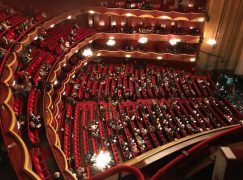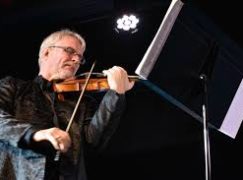NY Times massages the Met’s worst attendance
NewsNY Times Culture Reporter Javier C. Hernández has written a cheery report on how things are bound to pick up for the Metropolitan Opera when it returns from a planned month-long break. The Met will resume performing on February 28.
Buried in the middle of the article is this:
At the Met, where 77 percent of seats were filled the week of Dec. 18, attendance dropped precipitously as the virus surged, bottoming out at 44 percent in mid-January, before beginning to rise again. Now the Met, the largest performing arts organization in the United States, will have some time to ride out the next phase of the pandemic.
Down to 44%?
Nobody polishes the Met’s image like the New York Izvestia.






Uh . . . you do know that there’s been a pandemic going on for a while? And that arts organizations — at least here in the US — are stuggling to get audiences back into halls? Or are you just trying to find a reason to continue your hate campaign against Peter Gelb?
I’m clearly missing something here. Where exactly is the polishing? Seems to me to be a simple report of figures.
Quite cheery. Not as cheery though as Chicago WTTN’s Hedy Weiss who sees (and dutifully reports) a full house in the middle of a desert.
But then again, New York is not as lucky as Chicago, which enjoys the Bill Clinton of classical music, fully recharged after gratifying afternoons, leading Swan Lake one night and Handel the other.
The stuff of thrills (yes, the afternoons too).
The Met has already resumed performing. They did “Rigoletto” this afternoon, Saturday January 29.
Left unmentioned by NL was the Met’s decision to suspend performances for the month of February. Sales are usually dire during the cold months, and in the past they have experimented with dark periods, though never for an entire month. So yesterday was the last performance for four weeks, after which performances will resume on Feb. 28.
Considering the dreadful production and singing, it might be more correct to say they did in Rigoletto.
Rigoletto was on this afternoon and I thought it wasn’t a recording but live?
AND it was broadcast worldwide. I listene dto it live from Germany, where it was on one of the many excellent public radio channels; DLF Kultur.
I get a little tired of the spite, and the piling on. Criticism is one thing, but targeting is another.
Thanks for that I had begun to think I was going mad!
…attendance dropped precipitously as the virus surged…”
I suppose this had nothing to do with it? Be fair. There was nothing in that report except report.
Not to mention the snow storm yesterday in New York. But no, none of these things have anything to do with attendance, it is always and exclusively Peter Gelb who is to blame.
I don’t understand why people think that things can just go back to what there was, and we all pick up from where we left off? Life has changed, people have changed, one’s priorities have changed, the music profession has changed, and now one’s spending power for most is far less than before with the daily cost of living going up, inflation having risen, and yet salaries and wages haven’t gone up to meet it all. The whole thing has had a knock-on effect down a long chain in so many ways. For some, opera is simply not even relevant anymore.
During PG’s regime, there have been many performances (actual sold seats, not comped audiences) in the 40th percentile. For one glaring example, try the first revival of the LePage RING. A bloodbath of the highest order. The pandemic just made a bad situation worse (and provided a convenient excuse).
Last night’s FIGARO was conspicuously full looking, but in analyzing the orchestra, there was a suspiciously large percentage of under 25s, strategically placed to give the appearance of a full house. A sold house never looks like that. Too clever by half…
C’mon, what are you trying to say ? Gelb is now hiring youngsters to fill the seats just to avoid bad publicity on SD ?
Comps. Nothing wrong with the concept, but not as a sustainable business model. At least younger people are being exposed to the art form, and there is value in that.
The Met sells cheap tickets to students and, every Friday, to under-40s, in addition to comps. So there are plenty of young people downstairs at most performances.
The Met offered its employees two complimentary tickets to all shows in the final week of January, which they do when box office sales are weak. That is what likely accounted for the demographic shift you observed.
A comp is a comp is a comp, regardless of the recipient. Bottom line, less earned income for the Met.
If that policy is in effect, it is a relatively recent development.
That seems like a pretty straightforward comment without spin. NL, how would you spin it?
Omicron. It’ll come back just fine.
The picture says nothing. Was it taken 30 minutes before the start time or 5 minutes?
Please clarify: was it 44% of the audience or the performers?
What is your point here, exactly?
I don’t know that I’d label “bottoming out” as cheery whitewashing. What are they supposed to say?
Apparently Tony-Tom’s dancing slippers have been filled. How log before a new baritone is referred to as “strapping”?
We all know that the MET is on your “can do no right” list. Even so, I completely fail to see how this is polishing anything. Nobody is going to lead with how terrible attendance has been in the opening, especially when there’s damn good reason for it to be poor.
We need some sense of balance since the NYtimes writers are firmly in the “Met can do no wrong” camp.
That included Levine.
If Norman wrote the story headline for the NYT: “Met Crashes to Catastrophic Levels, Bankruptcy Predicted”
Cuomo and Hochul drove the monied opera audience away with their high-tax, dangerous liberal policies as have DeBlasio and Adams. BLM is more important to Democrats than the MET. Then there is Gelb tending to the mortuary of memories from decades past.
Apparently Blow’s Fire shot up in my bones was another stiff…
Sorry to bring some reality to you, but BLM *is* more important than the Met. On the one hand the living conditions of millions and millions of people, on the other refined culture for a few. Not difficult to pick. Fortunately, though, one doesn’t have to pick, since they can easily coexist with each other.
Drove them away to where? Florida? The only problem with moving to Florida (no State Income Tax) is………you have to live in Florida.
Don’t you have a Klan rally to attend somewhere? Why does this site attract such troglodytes?
What?
No room for YOU at Hillary Clinton’s house Krunoalav??? Just bring her a bottle and you’re in!
The only blacks she allows in are the maids..unless Bill finally turns up from Epstein’s island of course. No limit to his exploits since the 70’s with all those ‘skirts’ he raped along with his colored son he keeps gleefully hidden.
I looked at the opera offerings for the weekend within a two hour drive near the Black Forest in Germany. Prokofiev’s Love of Three Oranges in Stuttgart, Mozart’s The Magic Flute in St. Gallen, Shostakovich’s The Nose in Basel, Mozart’s Don Giovanni in Zurich, and Puccini’s Tosca in Freiburg. They were all sold out or close to it, though there are probably some covid seating restrictions.
There are five other full time houses within two hours, but I didn’t check them.
We chose The Nose since it is a very interesting work and rarely performed. We’ll catch Love of Three Oranges later since it is also rarely presented.
The ticket prices here are far cheaper than at the Met. You can have front row seats for Madame Butterfly in Freiburg for 55 Euros (about 60 dollars) and it is a quite respectable company. We saw Britten’s Turn of the Screw there in a truly excellent performance.
Front row seats at the Met are in the $400-$600 range, and to even have access to those tickets you have to be a donor in the $20k range or so, if I remember right. Most of the seats closer to the stage have brass name plates on them and are essentially owned by big donors.
The difference with the USA is public arts funding. It allows European houses even in small cities like Freiburg (pop. 200k) the stability to perform interesting repertoire in full time, year-round houses and to build large publics which includes extensive programs for children. Imagine the haughty Met with tickets for the best seats that average people could afford and having a highly developed program for children. Instead, it is a city with economic dichotomies found only in “Third World” countries.
I had best seats in the house in Teatro Colon for $2. (Same in Havana at Garcia Lorca, but we all know comm countries, including Russia, think the arts should be available to all). Top price in HK was about $140 last time I looked, with 50% off for students and seniors — I know nowhere in Canada that discounts these groups like that.
It’s been some years but I paid around 70€ for okay-ish seats in St. Petersburg’s Mariinsky Teatr. Something Tchaikovsky, Sleeping Beauty, IIRC. But I had to pay extra for not being Russian. Because.
Yes — I had to pay extra in Cuba as well. Mine were $2 each. A Cuban friend bought his for about a peso. As it should be. Imagine if, as a local, you got better prices than a tourist at home! Especially that kind of better.
“Imagine if, as a local, you got better prices than a tourist at home!”
Sure, but now your Cuban friends come to visit you, and suddenly they don’t have to pay 1CUP but 4800CUP ($200) while you only have to pay $4. Doesn’t sound very fair to me.
This scenario works only for countries with similar per capita income, otherwise, it massively favors the richer country.
You are comparing Champions League with Kreisliga.
No, he isn’t.
Not sure the Met would qualify for the Champions League. I think La Scala, Covent Garden, Bayerische Staatsoper, Wiener Staatsoper, Zurich Opernhaus, the Real and the Liceu would have a better claim.
Why don’t you complete the list? Also a better claim have the opera houses in Bari, Benevento, Catanzaro, Castellammare di Stabia, Corleone, Grosseto, Montalcino, Montepulciano, Scafati, České Budějovice, Veliko Tarnovo, Mangalia, Esztergom, Szentes, Amt Creuzburg, Dierdorf, Diepholz, Diemelstadt, Dommitzsch, Elmshorn, Elsdorf, Herbolzheim, Liebstadt (obviously), Melsungen, Mellrichstadt, Mendig, Mengen, Menden, Mühlheim am Main, Mühlheim an der Donau, Mülheim an der Ruhr, Mülheim-Kärlich, Mühlhausen, Rheinbach, Rheinberg, Rheine, Schüttorf, Schwäbisch Hall, Sontra, Uffenheim, Zeven, Eltendorf, Forchtenstein, Frankenau-Unterpullendorf, Mattersburg, Oberschützen, Oberwart, Rust, Unterkohlstätten, Bourg-Saint-Pierre, Cully, Gordola, Herisau, Maienfeld, Orbe, Pfäffikon, Sembrancher, Villeneuve, Aurillac, Châlons-en-Champagne, Chamonix (ask for Linda), Clermont-Ferrand, Le Puy-en-Velay, Loches, Lons-le-Saunier, Montbéliard, Tarbes, Trouville, Vitry-sur-Seine, and even I have to stop.
All of them have a combined budget less than that of the Met. All are state subsidizet and many of them do not even exist. But they are all in Champions League.
So one would like to think, but houses like Basel, Stuttgart, and Zurich compare quite well to the Met. The Met is way overblown, but most Americans will never know the difference since they barely even have a chance to hear opera.
I know the opera houses in Basel, Zurich and Freiburg and only Zurich can pretend to play in the same league as the Met, Freiburg is very far from it. Opera in Zurich is expensive as the cheapest tickets with unrestricted sight are at 168 CHF. You get plenty of decent seats for less in the Met. The real advantage of opera in Europe is diversity of repertoire. But there are interesting things in New York, too, like Fire Shut Up In Your Bones, or the recent excellent production of Porgy & Bess.
To cherrypick the top price seats at the Met is disingenuous. The house seats 3800, plus 200 standing room. Within those numbers, there are plenty of affordable seats.
With the exception of a few parterre seats, there are no tickets for regular performances in the $400-600 range. The highest orchestra seat is $320. There are only a handful of seats in the Parterre in the $460 range (front row and direct center).
However, the very highest price in the Orchestra is $320 (going down to a low of $85), and the Grand Tier (as low as $95), Dress Circle (as low as $85), Balcony (as low as $30), and Family Circle (as low as $30), respectively, are $295, $190, $100, and $35. These prices vary slightly by performance, but they are general ranges, and there are seats in all locations priced at a fraction of the premium seats. (If you want to faint, just look at Broadway prices.)
Yes, status as a donor guarantees early access to seating pre-season and admission to Patron lounges, etc, but any member of the public has access to any seat in the house.
The brass plates you mention have nothing to do with “ownership”. Rather, people make gifts to the Met’s endowment to honor or memorialize someone. It has absolutely nothing to do with future rights or privileges in the opera house.
You need to get out of the Black Forest occasionally. Don’t believe everything you read. Come. Visit. Enjoy….
Good point about subsidies. Also, many of the smaller companies offer free pre-performance introductory lectures, and in general take audience building more seriously than the big houses (the Met, but also Paris, Vienna).
William, you don’t have to be a big donor (or any kind of donor) to get the front seats at the Met, though the price range you quote is about right. Many are taken by subscribers who show up to the same seat every year for a certain number of performances. But you can usually get them if you book early. Why you would choose to sit so close is another matter and one of personal choice – you’d rather see than hear (since the best sound is upstairs in any one of the elevated tiers). Said tiers are more affordable and you can get a GREAT seat (front rows of Balcony) for the best sound and not too far back for around $150. Family Circle at the top has great sound for $25-ish and standing room is even less. Compared to Broadway, the Met is a bargain. And – it’s usually pretty wonderful and occasionally absolutely exceptional. That they can put on 5 or 6 different shows a week is a staggering logistical achievement.
I note you didn’t say you picked The Nose
Sorry, you’ve lost me here Mr Lebrecht. Are you disputing the figure of 44% per se? If so, on what grounds?
What do they expect? A run of Tosca, Boheme, and Figaro. Multiple impediments to entry due to mandating Covid restrictions. No tourists. Prices that are eye watering, even when the programme is more varied than mere T,B,F.
I fully understand the need for care but I suspect that the way many organisations are responding to the ongoing crisis is becoming counter instructive. Looking at the booking charts for Don Carlos at when they come back after the break it looks like things are not going to be much better.
Even given SD’s animus towards the MET they are in a bind that is being shared by many other houses and the longer it goes on the greater the long term damage will become irreparable.
Didn’t SD just report a plea by principals for attendance at Vienna Staatsoper?
No. Just no. I’ve been 12 times since the beginning of the pandemic and vaccination requirements – they staffed superbly to inspect your vaccination certification and photo ID. There is no delay getting in, even when house is full (and it has been). Prices are much less than Broadway for a good 50% of tickets. Houses have been full for the T, B and F you mention as well as the other T (Turandot) and for Fire Up in My Bones. You are entitled to your own opinions but not your own facts.
Oh come on. Why do you crucify the NYT? Why the tie to the communist USSR? Surely home-town media are allowed to root for the home team? The attendance drop phenomenon is everywhere. Surely some positive PR, in an era of non-stop bad news, can help fill a few more seats. And that is a good thing, no?:)
“Why the tie to the communist USSR?”
Maybe because the NY Times has a long history of covering up the atrocities of Communist regimes? See Walter Duranty, for example.
Borderline psychotic post.. whatever ones opinion of the Met, they haven’t missed a performance since reopening..
Very well pointed out. It’s tedious clickbait all this Met-bashing.
What’s your issue, Norman? You think 44% is too high? Or that they don’t describe it in apocalyptic terms? It’s winter and COVID is rampant; in that situation 44% doesn’t seem so bad.
And I was at the Baltimore Symphony last night; nice program, Nicola Benedetti the soloist, and I’m sure the crowd was not close to 44%. It’s not just the MET.
And the Times is a good paper. They fact check.
The Met never cancels because of the weather, but patrons do. Yesterday wasn’t the worst blizzard conditions ever but New Yorkers aren’t used to snow anymore and it was challenging to get around. Add to that pandemic caution, especially among a disproportionately senior matinee crowd, and you get a sparsely filled house.
“New Yorkers aren’t used to snow anymore.” LMAO. New Yorkers will endure anything short of a nuclear bomb.
Given the circumstances it was a wonder the Met was able to go through with all scheduled performances (now in winter hiatus until 28 February). I’m an enthusiastic patron but I haven’t gone since December for the obvious reason of the rapid rise of omicron infections in NYC in mid-December, which closed down many public and private events even without a mandate. I went to see Tosca on Saturday partly because I felt reassured in the house being far from sold out. I think the Met can be proud of its performance during this time.
What an ugly item! As a person who was exposed to both Izvestia and the New York Times, I can attest that there is no comparison. The NYT actually reported the figures out of which you concocted your story — what the Izvestia wanted to hide, you would never have found on Izvestia’s pages.
Also, I attend the Met regularly. Many in the audience are elderly. Is it somehow the Met’s fault that many elderly members of its audience decided to stay home during these days of spreading virus variant? Do you seriously think that this development has anything to do with the quality of the singing at the Met or the Met’s settings? What’s your real issue?
We don’t have that problem in La Monnaie in Brussels. The moment restrictions were lifted it was full-house mask-wearing or not. At the moment the house can only admit 70% of capacity by law. Same with concert venues – sold out.